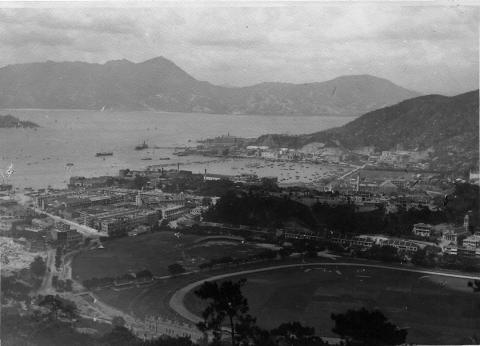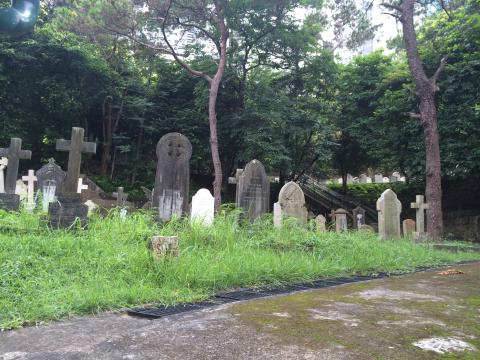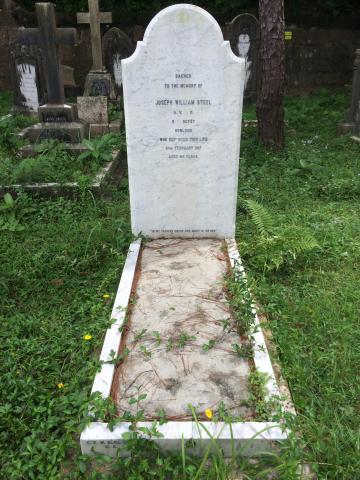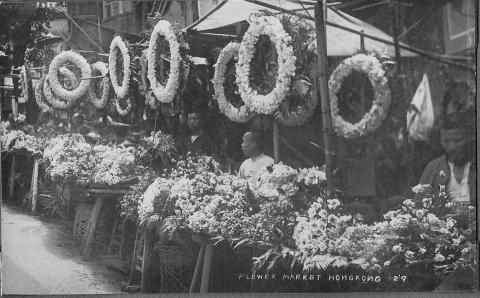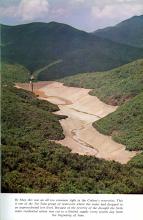Leaving School, Shopping and Father's Headstone
Primary tabs
In 1924 I had reached the top of the school (ed. note - she was 14), and my school days ended. The nuns asked me to stay on and teach English to a class of Chinese girls, as many of them knew little English. I agreed to try, but was not happy and gave it up after a few months, and began to learn Pitman's shorthand and typewriting to prepare myself for a career as a Secretary.
We moved down to Wong Nei Chong Road again and stayed with Mrs. Leach and Daphne. Mr. Leach being away at sea most of the time and the boys at school in England, Mrs. Leach was now taking in paying guests. The other lodgers were young bachelors, Western, Watts, O'Shea, Davies.
Happy Valley in the 1920sWe were waiting for new flats to be finished in Village Road at the end of the Valley, and as soon as they were ready, Mamma, Audrey and I moved into one.
In 1926 Terry got me my first job as Secretary in his office at the Hong Kong Telephone Co., and he used to take me in the side-car of his motorcycle. Daisy Kersey had come out from Home to marry Terry. She was a fine pianist and a trained singer. One of her songs was "There are fairies at the bottom of our garden" sung in a powerful but not pretty voice. Terry was very proud of his musical wife.
Douglas Munton, "Munts", joined Mamma's firm Shewan Tomes and Co. at this time and became her great admirer. He was generous to Audrey and me, took us to the Races, paid for all our bets and refused to accept any of our winnings!
Through his influence I joined the Hong Kong Government Service, and became Secretary to Mr. Tim Hazlerigg, the Treasury Solicitor at the Supreme Court. He and Munts were friends at the Hong Kong Club. I was just sixteen years old, and very proud to be earning my own money.
The Supreme Court was a beautiful building but inside there was a queer old musty smell. It stood on one side of Statue Square, a place of green lawns and pots of marguerites. In the centre of the Square, Queen Victoria sat enthroned under a canopy, flanked by various other statues, including Sir Thomas Jackson, Baronet, founder of the Hong Kong and Shanghai Bank, standing grandly facing his Bank.
Mr. Hazlerigg was a nice, kind man, and I liked working for him. Every morning without fail he used to ring up Robin Cotton, and hold a long conversation with her. She was a teacher in one of the Government schools. Mr. Hazlerigg was one of the Hong Kong grass widowers, like Munts, whose wives had not accompanied their husbands to Hong Kong. In later years Mr. Hazlerigg's wife died, and he married his Robin.
Now that I was earning money as well, we decided to order a headstone for Dadda's grave in Happy Valley cemetery, on the hillside behind the Racecourse grandstand. The headstone was of marble with Hong Kong granite enclosing the grave. On the tablet was inscribed Dadda's favourite text
"In my Father's house are many mansions" - John 14-2.
The cemetery was a pleasant place to walk in. It was beautifully kept by the Chinese gardeners, with flowering trees and shrubs and flowers in pots lining the paths.
Jack Grenham used to come and stroll with us in the cemetery, and sit by the fountain. We had made friends with him and Bert Burrows when Audrey joined a Naval concert party. Jack used to sing "I miss my Swiss" and yodel, Audrey and her friends sang "We're four poor Italianos" and "Two little sausages". Amateur concerts were all the rage in Hong Kong, when good, bad and indifferent singers appeared on the stage to sing old sentimental or stirring songs to the accompaniment of a piano. Sometimes professional concert parties came from England to perform in Hong Kong and Shanghai, and everyone flocked to see them.
Audrey and Winnie Henderson joined a dancing school run by Violet Capell and Daisy O'Keefe. They gave dancing displays. In her first solo dance Audrey was a nymph tripping about in a diaphanous dress, catching a butterfly in her cupped hands, to the strains of Sinding's "Rustle of Spring". In a Dutch clog dance the girls danced to Greig's "NorwegianDance No. 2", and other dances were performed to the haunting music of Greig's "Peer Gynt Suite".
When we were young in Hong Kong, Mamma made most of our clothes, as she had done in Wei Hai Wei, and many were the hours we spent in Tyeb's or Kayamally's, the Indian drapers' shops, choosing dress materials, needles, cottons, tapes, bias binding, ribbons and laces!
As we grew older, Mamma gave up dressmaking, and our dresses were made by a Chinese tailor. There were many of these little shops in back streets. In the front room were piles of English, American and French fashion books for us to pore over. From the back room could be heard the voices of the tailor's assistants and the whirring of sewing machines. Having chosen a style, we would hand over the imported English or French dress materials we had bought at Tyeb's or Kayamally's and the tailor would take our measurements and promise a day for fitting. It was wonderful how we and he could communicate in pidgin-English on the latest fashions! But these tailors and their workmen were real geniuses, and in about ten days would produce a smart dress, beautifully finished in every detail at very little cost. No wonder the Hong Kong girls were so well dressed!
Our underclothes were made in China, and we bought them in the Chinese silk shops. They were made of silk or satin, beautifully embroidered as only the Chinese knew how to, and adorned with lace. Our shoes were made by Chinese shoemakers, but our hats came from Mrs. Brennan, an American whose shop was a treasure house of smart American hats! And our stockings were of sheer silk. Our Amah washed and ironed all our clothes and the household things. She used a charcoal iron, and had to blow the coals frequently to keep them glowing. Never again would there be such perfect ironing!
On our way to the tailor's we walked up Flower Street past the open air flower stalls. All kinds of flowers were here, some loose and some in bunches with foliage round them, tied up with strong grass. You had to examine these carefully because sometimes the flower heads had been fastened on to pieces of split bamboo! They even made funeral wreaths, which hung over each stall. Mamma loved to wander along bargaining for flowers. My favourites were the dark scented violets sold in tight little bunches with a ruffle of their own leaves round them. But the two most precious flowers, only seen once a year, were the Chinese New Year flowers. Bowls of fragrant Jonquil Narcissi in full bloom - little white bloomswith yellow cups, growing in water and pebbles, scenting the air yards away. And the lovely Enkianthus, shining pink waxlike flowers dangling like bells under tufts of leaves at the top of long bare branches.
Hong Kong shops were Lane Crawford's and Whiteaway Laidlaw's, English Department stores, and their Chinese equivalents, Sincere's and Wing On's - it was a rickshaw ride to these two; Swatow Lace shops, selling exquisite Chinese embroidered table cloths and mats of cotton, linen and grasscloth, Swatow "drawn work", filet lace, Canton shawls of silk, with designs of birds, flowers and dragons heavily embroidered in coloured silks; English and Chinese jewellers and silversmiths, the Chinese gold lighter in colour and their silver softer than the "English" gold and silver; in the Chinese shops was beautiful jade of every shade and other Eastern gems. Chinese curio shops sold an infinite variety of Chinese vases, bowls, carvings and lamps, in cloisonne, jadestone, porcelain, bronze, ivory and wood.
